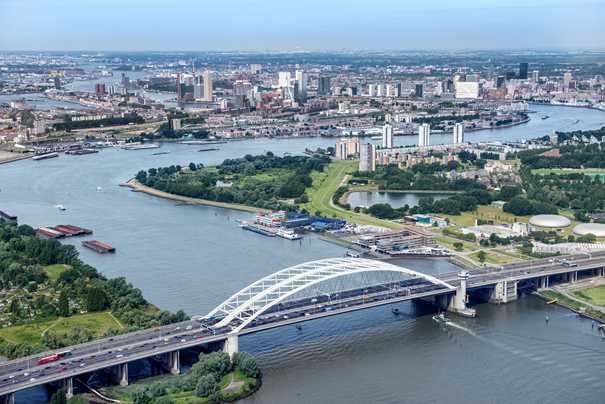
Ports and delta cities are environments where high resource depletion, pollutant emissions and human population density are concentrating. This constitutes a real challenge regarding reducing pressures on the environment and society. Important pressures in port and delta city environments include contamination, sewerage, land reclamation, construction & dredging, regulation of water levels and shipping. Physical alterations of the port environment caused by human activities (e.g. dredging, construction of locks and pumps) change the natural characteristics of shorelines, which subsequently can lead to problems such as unnaturally high sedimentation rates or a decrease in fish migration opportunities. Due to climate change and the associated (enhanced) sea level rise, the pressure on ports and delta cities will further increase.
The Building with Nature concept can contribute to solving the challenges in ports and delta cities in such a way that ecological, economic and societal benefits are combined. Building with Nature solutions can for example contribute to reduce the ecological footprint of port infrastructures while developing (new) ports (e.g. by enhancing the nursery function for fish) and can be applied to reduce flood risk and improve sediment management (e.g. by creating natural slopes enhancing wave attenuation, optimising dredging strategies and flow patterns). Additional benefits include the creation of attractive, green living environments within the densely populated cities.
The ecosystems of ports and coastal cities provide multiple resources and processes from which mankind can benefit, known as ecosystem services. For example, ports and coastal cities provide food (e.g. fish, shellfish), construction materials (e.g. sand), alternative energy resources and opportunities for industries, transport and tourism. Benefits arising from how the system regulates processes, resources and its own properties include coastal protection by tidal flats and salt marshes, carbon sequestration, water quality regulation and temperature regulation (e.g. sea moderates temperature swings in cities). Furthermore, non-material benefits associated with ports and cities include possibilities for recreation (beach trips, snorkelling etc.), research and education, culture (e.g. heritage, cultural exchange) and aesthetic value. Finally, ports and coastal cities offer supporting ecosystem services, e.g. they provide habitat for animals and plants.
With the application of Building with Nature these ecosystem services are used while solving the challenges in ports and delta cities.
System description
The physical/ecological conditions in port and delta city environments can be very diverse, since they may occur in a range of climates and environments. To be able to apply Building with Nature solutions it is important to fully understand the system of interest, not only the physical/ecological conditions, but also human activities/pressures and governance processes.
Physical/ecological conditions
A broad system understanding is important to be able to apply Building with Nature. Aspects that might not directly be seen as relevant could turn out to be relevant for a specific BwN solution.
For succesful application of specific Building with Nature strategies the right physiological and biological conditions need to be present.
Important boundary conditions for the design of the BwN measures are:
1. Shoreline/bank type (general condition)
2. Water movement: river discharge, waves, tides;
3. Morphology and type of substrate (slope of riverbed, substrate strength, depth);
4. Light conditions: sunlight hours, transparency of water, angle of incidence of the sunrays, water penetration depth;
5. Salinity: fresh, brackish, salt;
6. Water quality: nutrients, oxygen, toxic substances, temperature, sediment concentrations, percentage of algae;
7. Connectivity: the accessibility of different water bodies by migrating fish.
Shoreline/bank type (1)
In ports and delta cities Building with Nature opportunities are generally located at or near the land/water interface. Therefore, the first step in identifying possibilities for the application of Building with Nature is to determine which shoreline or bank type is present and what alterations are possible. After this step, boundary conditions can be investigated in more detail.
Water movement (2)
There can be a large difference in water level due to tidal and climatic changes (wind set-up and river discharge), depending on the location of the port/city. The area influenced by high and low tide is called the intertidal zone. In terms of water movement, the species within this intertidal zone need to be able to cope with certain flow velocities, waves and dry periods during low tide. The variation in water level influences the area of the intertidal zone where plants (fresh water) or seaweed and shellfish (salt water) are present. The effect of the high tide and low tide on the vegetation in a fresh water tidal area can be seen in Figure 1. This effect of tidal range on the vegetation zone has been studied in the Biesbosch delta estuary (NL). (Human) constructions that alter the tAny human construction that impact the tidal range will also impact the tidal zone.
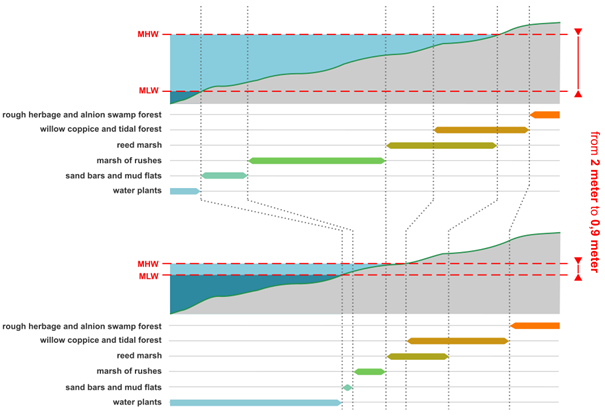
Morphology and substrate (3)
The size of the tidal zone not only depends on the tidal range, but also on the bed slope. More plants can settle down and grow if the shore has a gentle slope. In the saline and brackish area, the slope steepness determines the type of shellfish species and weeds which are present. A typical, natural slope steepness for shoals is between 1:10 and 1:20.
Sediment can settle easily in port basins as a result of the low flow velocities in these areas. Ports thus have a natural tendency to silt up which is not convenient for the operations of a port. Therefore, dredging is necessary on certain locations to maintain a water depth suitable for navigation. Ports expand due to the increasing size and amounts of ships.
The natural characteristics of a shoreline change, because of the urbanisation and implementation of constructions. Natural shoals are changed into rubble mounds (hard substrate) (Figure 2 and Figure 3). Urban structures in ports, such as pilings and pontoons, create novel habitats for plants and animals to grow on, quite distinct from natural rocky reefs. However, due to the waves and high flow caused by ships, flora and fauna can not easily settle or grow on the hard substrate. Flora and fauna develop better on substrate located in the areas which are less influenced by waves.
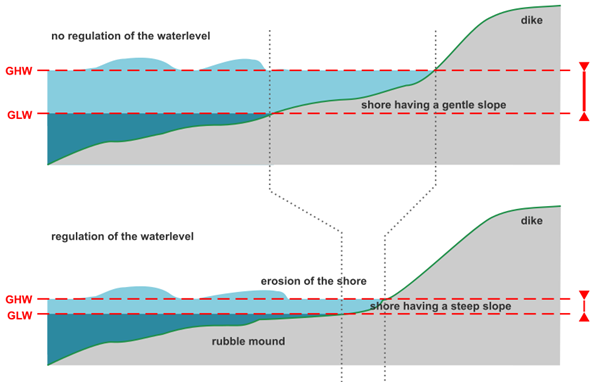
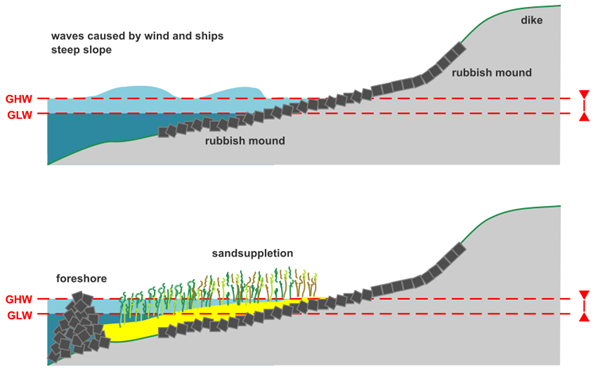
Light penetration (4)
Waterplants and seaweeds need a certain amount of light to grow. The amount of light decreases with depth with a rate determined by the water transparency. If the water depth is too large, unsufficient sunlight reaches the river bed so that fewer species can survive. The dissolved oxygen concentration influences the flora and fauna as well. If the dissolved oxygen concentration is too low, flora and fauna die. A shortage of oxygen occurs especially at places with a high water depth in combination with a low refreshment rate (e.g. docks, basins). A low refreshment rate results in stratification leading to a shortage of oxygen at the bottom of a water body.
Percentage of salt (5)
The concentration of salt in the water, which is affected by e.g. seasonal variations in river discharge, strongly influences the presence of certain species (Figure 4). In general, the amount of fresh water fish decreases at salinity levels larger than 0.6 g Cl/liter. Species which are suitable for fresh water can survive a short period of 1,6 gram Cl/liter. Some species can protect themselves by closing their shelf. Fish can swim more upstream where water is less salt. However, when the amount of chloride is above 1,6 g Cl/liter, the highly sensitive species will die. Even the less sensitive species will die when this amount occurs for a longer period. On the other hand, species suitable for salt water can survive when the amount of chloride is lower for a certain period. In between the 3-4 gram Cl/liter there are less species since this is in general too saline for fish suitable for fresh water and not saline enough for fish suitable for salt water.
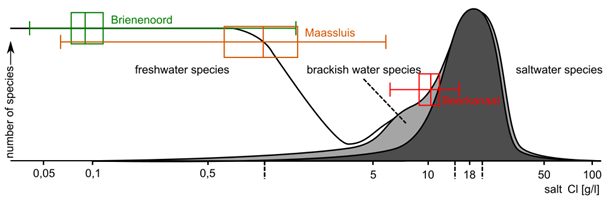
Water quality (6)
The amount of nutrients, oxygen (influenced by water depth and sunshine), temperature (influenced by sunshine), sediment, algae etc. determine the water quality. The water quality in ports and cities is strongly affected by both the water from the river and sea that flows into the area. In Europe, international water quality standards have been developed as a river often flows through several countries.
Connectivity (7)
The connectivity between polders, rivers, tidal areas and the sea is highly important for fish migration. Especially in highly developed ports, migrating fish have to pass locks and pumping stations. These locks and pumping stations have a negative influence on fish migration. In the Netherlands, new pumping stations have to be fish-friendly.
Human activities and pressures
Surface waters which, as a result of physical alterations caused by human activities such as the construction of dikes or development of ports and industries, are substantially changed in character and cannot meet the requirements of a good ecological status, are considered heavily modified water bodies (HMWBs) within the European Water Framework Directive (2000/60/EC, WFD). Many port environments in Europe are designated HMWBs.
Important pressures in ports and delta cities are:
- Contamination: contamination can have detrimental effects on port ecosystems. Port basins have long been recognised as a sink for fine sediments and, because of the fact that contaminants adhere easily to fine sediments, for many contaminants like polycyclic aromatic hydrocarbons (PAHs) and tributyltin (TBT) (e.g. Martınez-Lladó et al., 2007).
- Sewerage: port habitats which suffered from historic sewage pollution or hypoxic events can have a significantly higher organic carbon, nutrient and trace metal content in the sediment than sediments in offshore areas or marine reserves, as shown in subtropical marine environments by Chan et al. (2016). Nowadays, many ports are still polluted by untreated sewerage;
- Land reclamation: land reclamation can be part of the development of ports and coastal cities, leading to highly altered environments. Reclamation projects change the living environment of marine organisms and can cause a decrease/increase in biodiversity and change in the structure of ecological communities.
- Construction & Dredging: dredging is an ongoing activity in and around many ports in the world. Repetitive maintenance dredging operations can cause sound disturbances and higher suspended sediment concentrations. Construction activities can permanently alter existing systems.
- Water level control: Figure 2 shows the effect of water level control on the shore. In combination with currents and waves induced by shipping this could lead to more shore erosion.
- Shipping: the increasing amount of ships and the increasing size of ships lead to more and higher waves influencing the shore and nature.
Governance processes
Port cities
In the traditional port city, port and urban functions are located close to eachother and sometimes intermingle. With the need for development of huge industrial port complexes, as well as changing public awareness of ecological and environmental waterfront issues, the port functions have migrated outside the city. At the end of the last century, spatial as well as functional segregation between ports and cities have become evident in many port cities around the world (Hayuth, 1989).
Port cities are areas where high resource depletion, pollutant emissions and human population density are concentrating. This constitutes a real challenge regarding reducing pressures on the environment and society. Many port cities thus seek to optimize resource and waste management by promoting interaction between different stakeholders occupying a common geographic area (Cerceau et al. 2014).
Port authorities
Most port authorities have formalised objectives for sustainable development (Verhoeven, 2011). The increased focus on negative appearance of port operations has reinforced the regulator role of port authorities in the fields of environment, safety and security. Many port authorities have their own safety, security and environmental departments and issue their own regulations in these three fields. There are however not many that go beyond mere transposition of legal requirements from existing national and international regulations, although several port authorities do claim to add additional legal requirements in implementing and developing actions to enhance sustainability (Verhoeven, 2011).
Sustainable development
Policies for sustainable development of transport rely on three pillars: striving for stable social and economic growth, while reducing pollution and protecting natural resources. Seaports play a significant role in economic growth of port cities. Levels of environmental awareness amongst port authorities have increased the last decades. In the 1990s, besides the priority of port function, environmental impacts associated with engineering developments were often a significant factor in the decision-making process (Forbes, 1996). Most effort has been focussed on reducing pollutants emissions (Kotowska, 2016). However, other environmental issues are also of concern. For example, protection of limited seagrass resources can be an important governmental concern. Ecologically and economically important seagrass habitats are often found in sheltered coastal sites that are threatened by port and port development. The Building with Nature concept can contribute to ecological applications such as restoration and ecosystem management, whilst developing new ports.
Ecosystem services
The ecosystems of ports and coastal cities provide multiple resources and processes from which mankind can benefit. These benefits are known as ecosystem services. In 2004, the United Nations Millennium Ecosystem Assessment (MEA) (see e.g. Millennium Ecosystem Assessment, 2005) and more recently ‘The Economics of Ecosystems and Biodiversity’ (TEEB) studies, divided the ecosystem services into four categories:
- provision, such as the production of food and water;
- regulation, such as the control of climate and disease;
- cultural, such as spiritual and recreational benefits;
- support, such as nutrient cycles.
Provision
Provision concerns natural resources, including products that a society gets from ecosystems. Examples of products that are provided by ports and cities (i.e. provided by their ecosystem, not the standard products and services that cities and harbours offer) are:
- Food, such as fish, shellfish etc. Fishing, whether via boat or from the shore, is popular in and near ports and coastal cities. Other provision providing activities are e.g. collecting shellfish and bait. Coastal areas of ports and cities provide nurseries for seafood species.
- Construction materials: such as sand and mud dredged during channel and harbour basin maintenance, which can be used for construction works.
- Alternative energy resources, derived from e.g. wind, waves, tides, algae.
- Opportunities for industries, transport, tourism etc. These are important economic sectors that use the sea and river for transportation of materials and people, cooling water for industrial processes, etc..
Regulation
These are benefits that arise from how a system regulates processes, resources and its own properties. Benefits obtained from regulation by ports and cities are:
- Coastal protection against flooding and erosion. For example, tidal flat and salt marshes in port areas such as the Wadden Sea ports provide coastal protection through wave attenuation.
- Nutrient cycling providing biogeochemical activity, sedimentation and biological productivity.
- Carbon sequestration. Marine and coastal ecosystems, specifically vegetated coastal habitats (i.e. seagrass meadows, mangrove forests and salt marshes), provide value for climate change mitigation through the storage and sequestration of carbon (also known as blue carbon ecosystems). Ports and cities may include such areas therewith providing regulating services.
- Water quality regulation through absorption, biodegradation, filtering and/or dilution of nutrients, pollutants and other wastes. Marine sediment and water in port areas are often chronically polluted due to port activities. Studies indicate that the bacterial communities in such areas have a greater abundance of organic compounds degraders, including oil hydrocarbons (Newton et al., 2013).
- Temperature regulation for city inhabitants. The sea cools the city and moderates its temperature variations.
Cultural
These are non-material benefits people enjoy. Examples of the non-material benefits obtained from ports and cities are:
- Possibilities for recreational activities such as fishing, beach trips, swimming, snorkelling, diving, boating, sunbathing, strolling along the boulevard, bird watching, surfing, sailing, canoeing and yachting. A large part of the human population lives and works in or near ports and coastal cities, so this ecosystem service is of value for a lot of people;
- Research and education, for example, harbours and delta cities are the perfect environment to inform people about opportunities for sustainable development in heavily cultivated areas;
- Cultural. Traditionally, port cities can be seen as a site of cultural exchange where people from different parts of the world meet, mix and influence one another. Ports and cities can also be connected to cultural heritage and identity;
- Spiritual, religious and artisan values. Ports and coastal cities are of importance as spiritual locations and as inspiration for artistic activities;
- Aesthetic value: the appreciation of the sea, river and harbours (including sandy beaches, rocky shores, tidal flats, river banks and mighty ships etc.) make ports and delta cities an attractive living environment. This may manifest itself in higher real-state prices close to the waterfronts in delta cities.
Support
Some processes are necessary to enable the other three categories of ecosystem services, without yielding direct benefits to humans (e.g. sustaining critical ecosystem processes that determine the vitality and resilience of ecosystems). Examples are:
- Habitat provision for animals and plants. Ports and cities areas are often characterized by strong gradients and discontinuities, particularly with respect to the distribution of nutrients, organic matter, oxygen, pollutants and sediment quality, which in turn will determine species presence and abundance.
- Refuge and forage area for different species. For example, provision of nesting, resting and foraging habitat for shorebirds, waterfowl and migrating birds along natural and human made objects such as jetties, piers, quays, dikes, dams, berms, islands and flats.
- Many shallow coastal areas offer nursery habitats for e.g. fish and shellfish.
- Resilience to human impact and natural hazards: the coastal ecosystems of ports and cities may assist in recovery after natural (e.g. storms) or human-induced disasters (e.g. oil spills).
Building with nature opportunities
Although the available space can be limited, both ports and cities offer numerous opportunities for the application of Building with Nature. In ports, the focus mainly lies on sediment management (e.g. clay ripening). In cities the focus of Building with Nature measures mainly lies on flood protection measures (e.g. mangrove/salt marsh restoration) and combining the creation of opportunities for flora and fauna with improving the spatial quality of the city (e.g. construction of tidal parks). Under ‘Read more’ an overview is given of BwN options for ports and cities including their relation with ecosystem services. Also, some examples of projects are given.
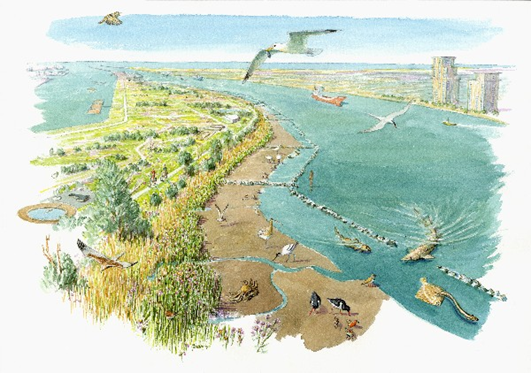
BwN options
De Jong et al. (2016) describe a number of BwN options for ports and cities and their relation with ecosystem services. These are summarised in the table below. For more information on the opportunities in delta cities visit the website http://www.buildingwithnatureinthecity.com, a product of Ecoshape. You can find factsheets for most of these options with detailed information about all sorts of themes like ecosystem of interest, ecosystem services, costs, maintenance, examples of application in practice, and so on.
Table 1: Possible BwN options with ecosystem services (http://www.buildingwithnatureinthecity.com; De Jong et al., 2016).
| BwN opion | Ecosystem service | Scope of application | Location | Image & link |
| Pole and pontoon hulas | Enhance biodiversity and ecological connectionWater purification (when shellfish are settles) Stimulation of water recreation (scuba diving)Source of food (possibly)Wave attenuation (small) | -Fresh – salt waterShallow – deep waterSmall – medium intervention | Many options for placement due to the small scale of this design option. Particularly interesting in front of revetments and vertical walls. | 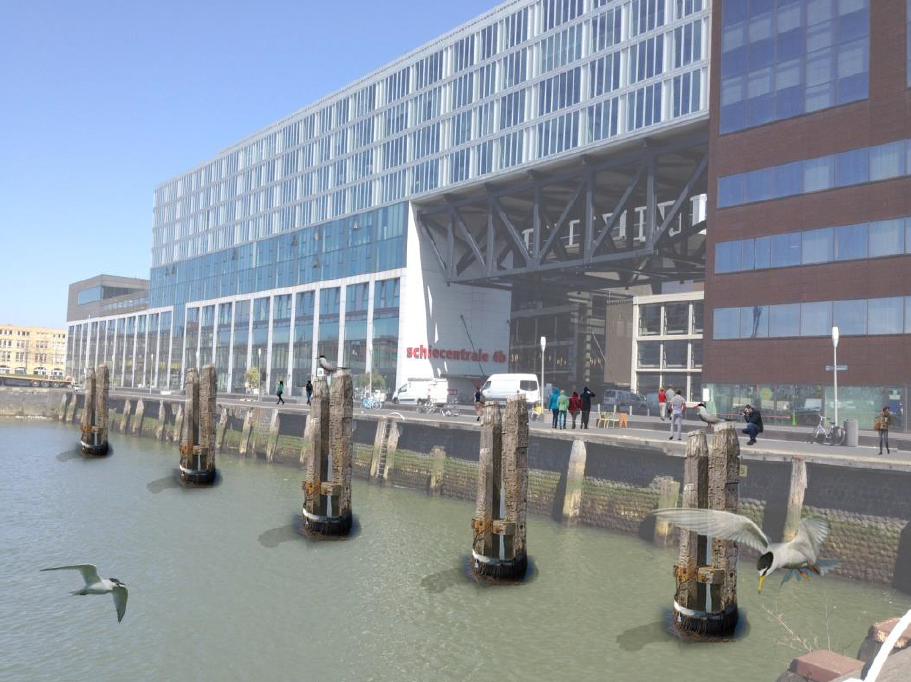 Habitat opportunities in harbours – Port of Rotterdam, NL Habitat opportunities in harbours – Port of Rotterdam, NL |
| Reef balls | Enhance biodiversity and ecological connectionWater purification (when shellfish are settles)Stimulation of water recreation (scuba diving)Wave attenuation | Fresh – salt waterShallow waterSmall – medium intervention | Often used in fresh water areas/lakes but just as well possible in coastal areas | 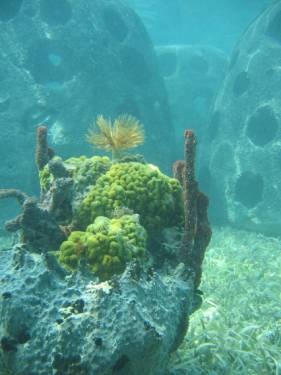 Knowledge – Artificial Reefs Knowledge – Artificial Reefs |
| Floating mats | Wave attenuation Shoreline protection Water purification Enhance biodiversity and ecological connection Carbon fixation Greening of shorelines | Fresh waterShallow – deep waterSmall – medium intervention | Fresh water systems with low wave attack | 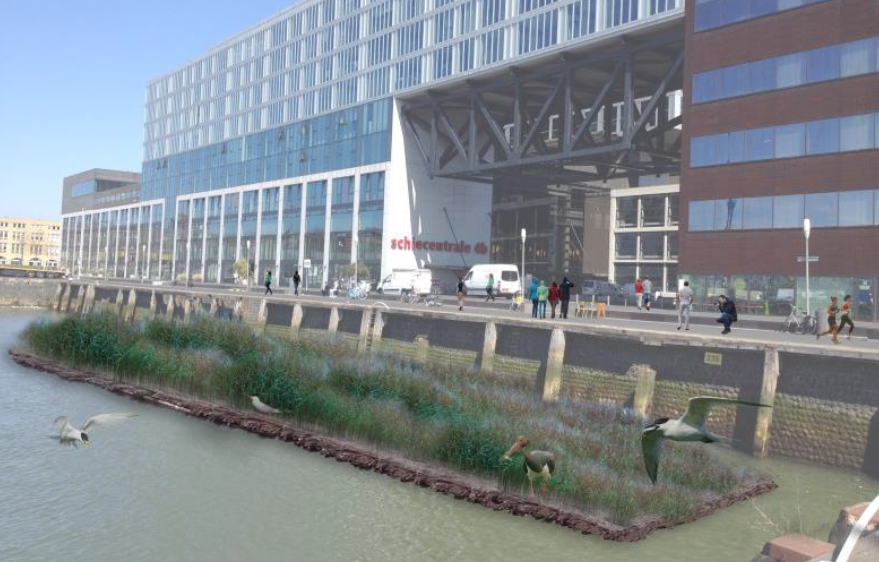 Shoreline protection by floating marsh – Houtribsluices, NL Shoreline protection by floating marsh – Houtribsluices, NL |
| Underwater garden and tidal pools | Enhance biodiversity and ecological connection Breeding grounds Substrate diversity | Brakish – salt waterShallow waterSmall – mediumintervention | Sloping revetments, dikes and beaches | 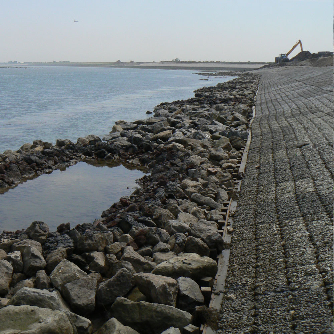 Enriching revetments Enriching revetments |
| Oyster reef and mussel bank | Wave attenuation Protection tidal flats Shellfish production (consumption) Enhance biodiversity and ecological connection Water purification | Fresh – salt waterShallow waterMedium – large intervention | Low to intermediate wave attack, shorelines suitable for shell fish | 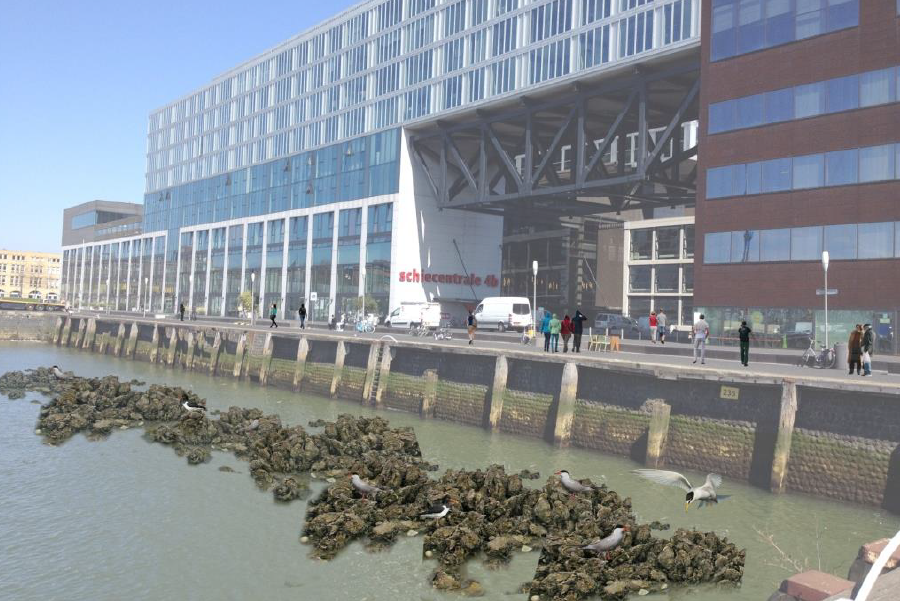 Habitat requirements for shellfish Habitat requirements for shellfish |
| Natural slopes | Substrate diversity (Natural alternative for shoreline protection by rocks and stones) Enhance biodiversity and ecological connection Carbon fixation Greening of shorelines | Fresh – salt waterShallow – medium water depthMedium – large intervention | Many locations, if space is available | 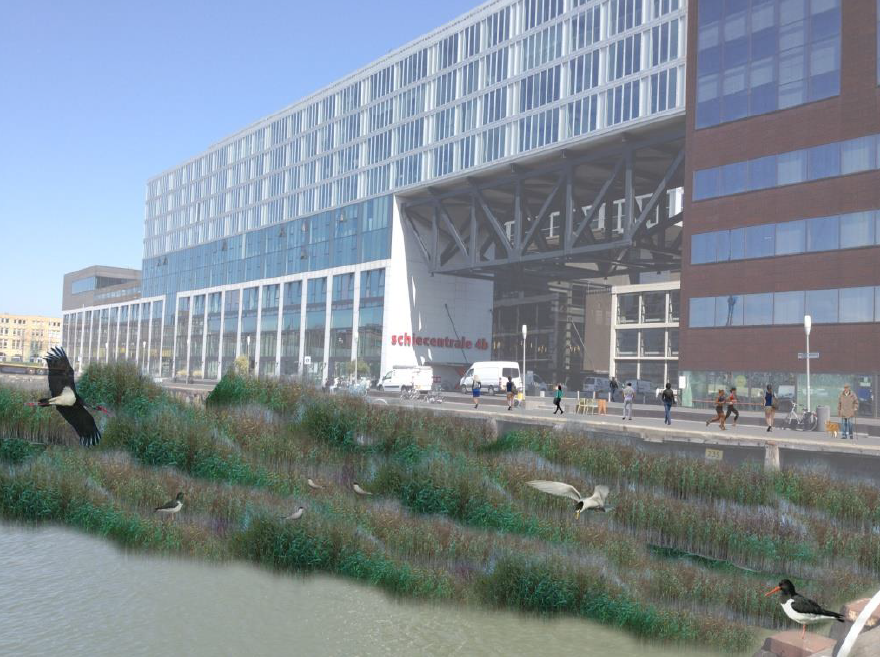 Foreshores in freshwater environments Foreshores in freshwater environments |
| Willow forest | Wave attenuation Shoreline protection Water purification Enhance biodiversity and ecological connection Wood production Carbon fixation Greening of shorelines | Fresh waterShallow waterMedium-large intervention | Fresh water areas, sloping shorelines | 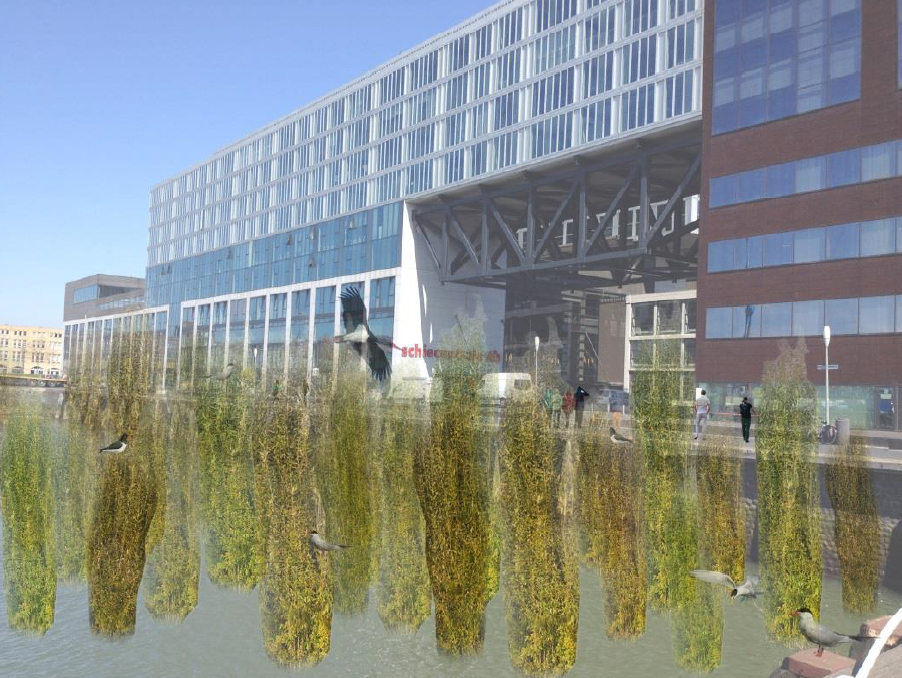 Wave attenuating willow forest – Noordwaard, NL Wave attenuating willow forest – Noordwaard, NL |
| Natural wetland and wetland park | Water purification Water storage Food production production (cane, crabs etc) Enhance biodiversity and ecological connection Greening of shorelines Wave attenuation Carbon fixation Wood production | Fresh waterShallow – medium water depthMedium – large intervention | Fresh water (swamp types)Salt water (salt marsh, mangroves)Low to medium wave attack | 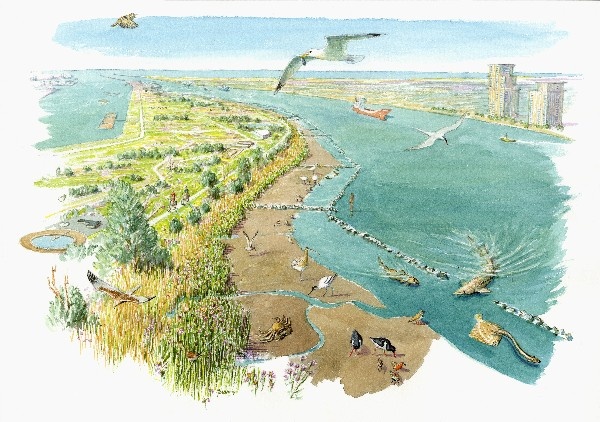 Building with Nature in delta cities – Dordrecht and Rotterdam, NLSalt marsh construction – Marconi, Delfzijl, NLMud Motor port of Harlingen – Koehoal – NL Building with Nature in delta cities – Dordrecht and Rotterdam, NLSalt marsh construction – Marconi, Delfzijl, NLMud Motor port of Harlingen – Koehoal – NL |
| Sediment management | Reducing carbon emission Enhance biodiversity and ecological connection Clay ripening | Brakish – salt waterMedium – large intervention | No restrictions | 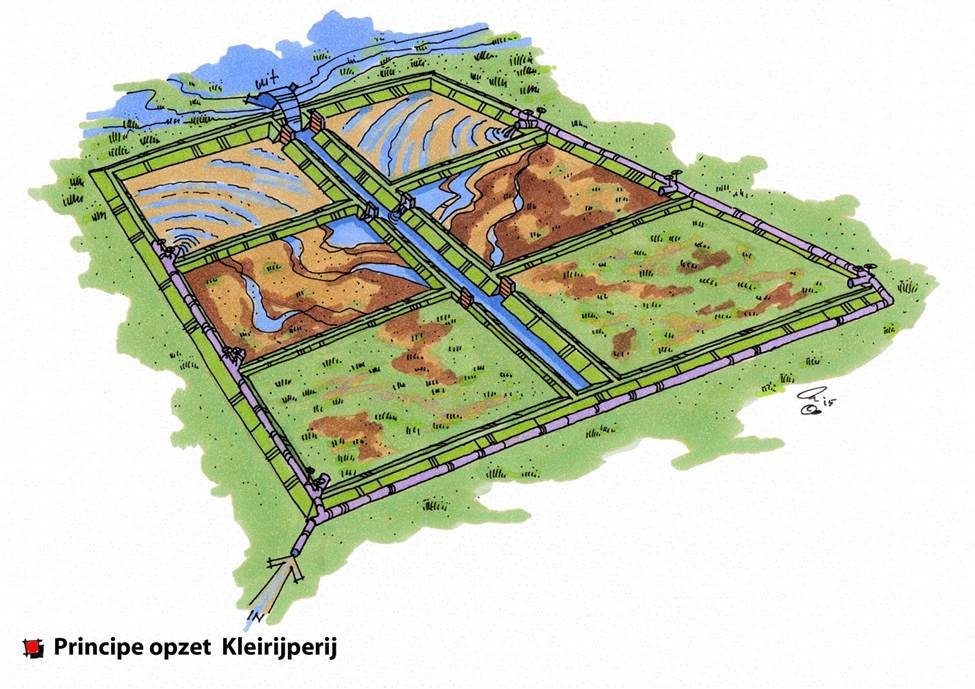 Clay Ripening Pilot Project, Delfzijl – NLMud Motor port of Harlingen – Koehoal – NL Clay Ripening Pilot Project, Delfzijl – NLMud Motor port of Harlingen – Koehoal – NL |
| Adapting estuarine gradients by diverting fresh water outflow | Enhance biodiversity and ecological connectionGreening shorelinesBreeding groundsSteering sediment transport | Fresh – salt waterShallow – medium water depthMedium – large intervention | Areas with fresh water outflow | 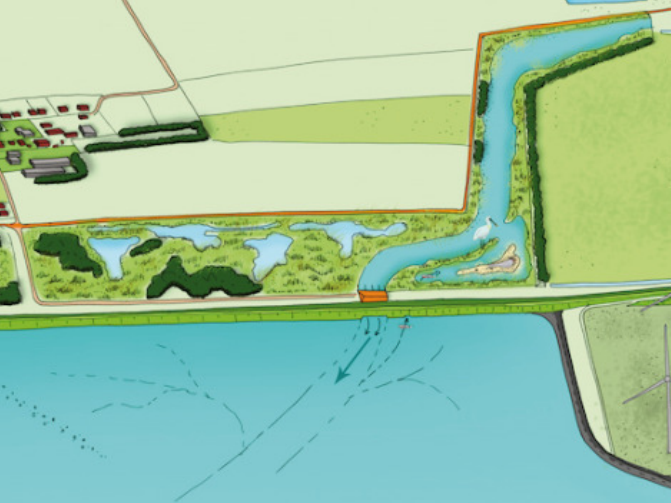 Van Eekelen et al. (2016). Van Eekelen et al. (2016). |
Example projects
In the table above, already some links with example projects are given. Some additional examples are given below.
Tidal parks in the city of Rotterdam
A tidal park creates leisure opportunities and improves the ecological quality of the city. Furthermore, a gentle, vegetated slope of the river bank breaks waves when water levels are high, which contributes to flood risk management. The opportunities for the creation of tidal nature using the Building with Nature design principles are being studied in Rotterdam (see also more explanation about pilot projects).
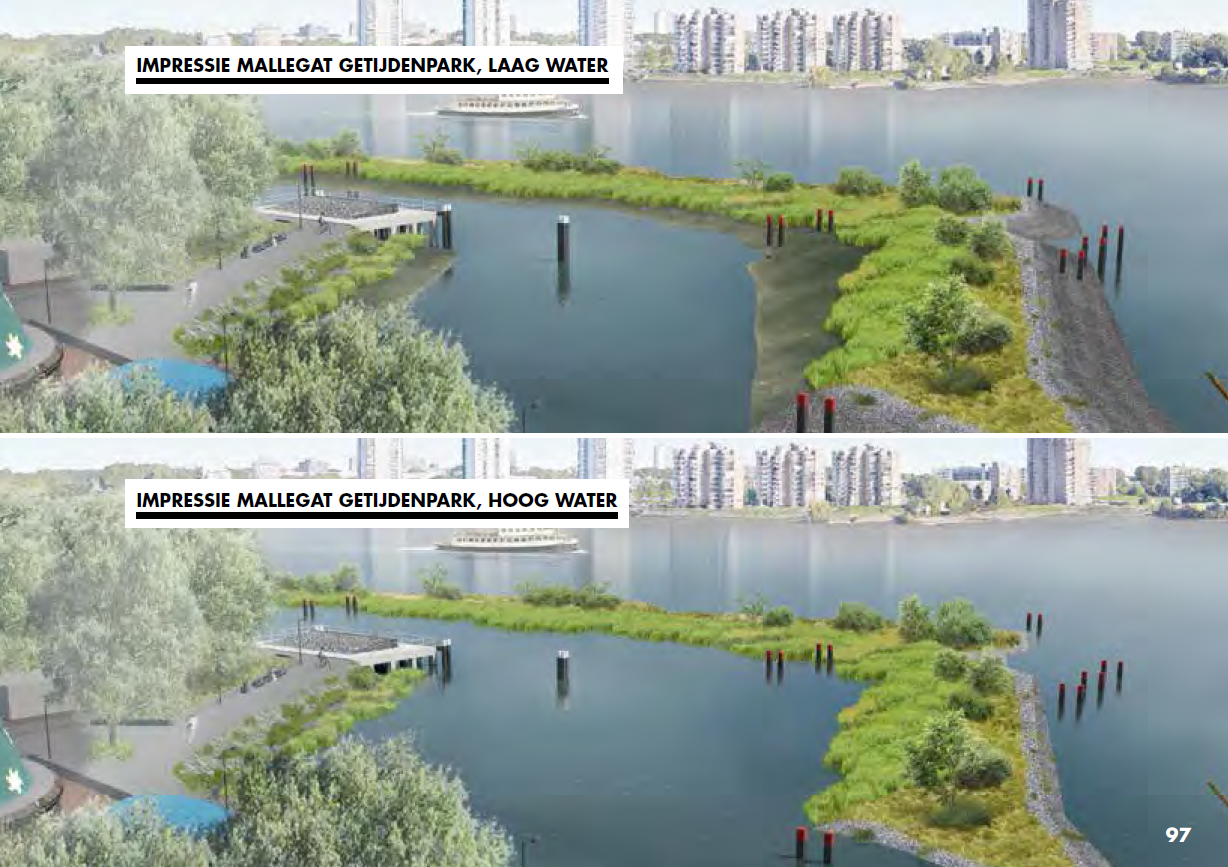
Creation of more space for nature and leisure in the city of Dordrecht
The creation of a tidal area in a city park can promote natural diversity in the area and attract more insects, birds and bats. The park could also be used for recreation. This is demonstrated in the city of Dordrecht (Wervenpark) (see also more explanation about the pilot project Wervenpark), were a tidal park is created as a natural ‘stepping stone’ to the Biesbosch National Park. The park will also include a walking trail and playing facilities. The tidal dynamics are used to manage the vegetation on the slope of the river bank, which lowers the maintenance costs.
Enhance the nursery function for juvenile fish in ports
Coastal and marine infrastructures such as ports, marinas and coastal defence structures are localized in sheltered and shallow coastal areas, thus these infrastructures inevitably lead to the loss of natural essential habitats once used as nursery ground by juvenile fish. Small artificial habitats are promising ecological engineering tools to enhance the nursery function inside ports and thus reduce the ecological footprint of those infrastructures.
Wadden Sea ports
The Wadden Sea (World Heritage site) is a large estuarine and embayment area in the Netherlands, Germany and Denmark. Several BwN options from the table above have been used in pilot studies to develop sustainable Wadden Sea ports. Baptist et al. (2017) and Van Eekelen et al. (2016) mention four BwN concepts that have been used in port designs.
- optimising dredging strategies (sediment management)
- enhancing saltmarsh development (natural wetland and wetland park; natural slopes)
- creating estuarine gradients (estuarine gradients; natural slopes)
- optimising flow patterns (sediment management)
Based on these concepts, three case studies have been identified and pilot projects have been initiated. In the Port of Harlingen a pilot project has started (project ‘Salt marsh development Koehoal by means of a Mud motor’) in which an optimized dredging strategy is combined with saltmarsh development. Around the Port of Delfzijl (Marconi project) an estuarine gradient is combined with the construction of a salt marsh and dredged sediment is used for dike strengthening. For the Port of Den Helder, a new design is proposed in which the concepts of enhancing salt marsh development, creating estuarine gradients and optimizing flow patterns are combined.
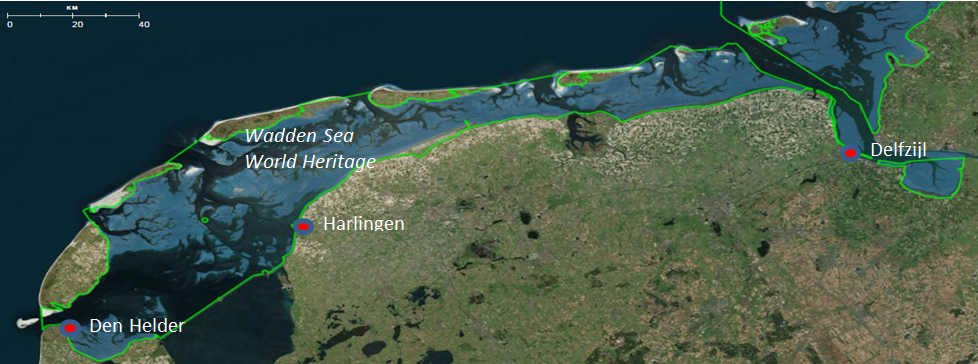
Sediment management – clay ripening
Large amounts of sediment accumulate in ports, making regular dredging necessary. On the other hand, clay soil is needed in other areas to strengthen dikes and to raise farmland. Collecting sediment from the port area and converting it into clay soil creates a win-win situation: the water quality improves and there is more clay soil for reinforcing dikes and raising farmland. In the Netherlands, the Clay Ripening pilot project has been initiated by Rijkswaterstaat in coorporation with several other parties including EcoShape, to look at different ways of transforming sediment into clay resources.
Lessons-learned
So far, the different projects in ports and cities within the Building with Nature programme have taught us a number of lessons. These concern the physical and ecological processes, but also bio-physical interactions and governance.
Physical processes
- Knowledge of sedimentation and erosion processes is important for the feasibility of the BwN measures in the water environments of delta cities and ports. Specific examples are:
- Sedimentation behind a breakwater can cause a high amount of landfill that makes the area unsuitable for aquatic flora and fauna.
- Too high hydrodynamic conditions may hinder the settlement and growth of aquatic vegetation.
- Mudflat and saltmarsh accretion needs to be large enough to develop to a minimum morphological height suitable for vegetation settlement and growth.
- A challenge in urban areas is that the available space is limited and scattered, while natural processes often need space to develop any succession or to reach higher levels of service. Understanding of the physical system and the participation/contribution of processes helps to design an intervention that will allow natural processes to develop an ecosystem within the borders set by the urban development.
- The design has to be adaptable: it must be possible to make small adjustments during the operational phase of the Building with Nature intervention to cope with the unavoidable uncertainties when building with living nature. For example, if the tidal bank system is eroding more than expected or sedimentation processes were underestimated, it should be possible to further close or open the inlet of the parallel dam that protects the foreshore. With a flexible Building with Nature solution one is able to build what is necessary at that moment and adjust it as the understanding of the system develops or the impact of climate change grows.
Ecological processes
- The BwN approach can only take advantage of the ecosystem services that correspond to a specific environment: not all BwN solutions are possible everywhere. It is recommended that an ecologist with knowledge of the ecosystem and relations between abiotic conditions and nature is involved in the design process to provide realistic and sustainable solutions.
- It is important to understand that there is a positive relation between biodiversity and the area of implementation and also that there is a minimum area below which the measure is ineffective.
- In ports and cities, free space for nature development is scarce. A solution is to think in terms of ecological networks. By incorporating several smaller areas into bigger networks, one can increase the effectiveness of the measure for nature in a wider region.
Governance processes
- Start with integrating BwN at the very beginning of the project initiation.
- Co-operation between funding bodies, governments, research institutions and private parties gives rise to complex juridical and financial arrangements that require a lot of time to implement into contracts. Yet such cooperation is instrumental in achieving sustainable objectives.
- It is important not only to look at the costs of measures, but also to quantify the benefits of ecosystem services. This helps to create support for the measure among the stakeholders involved.
- In an urban environment even more stakeholders can be involved than in a regional environment. This can be a drawback because of many conflicting interests and the often long-lasting procedures that follow. However, it is often a strength providing a lot of innovative thinking and creating carrying capacity and awareness.
- The fact that pilot projects have been initiated for ports in the Wadden Sea area and that they are supported by local and regional authorities and stakeholders, already contributes to the success of these Building with Nature concepts.
References
- Banks, J., L.H. Hedge, C. Hoisington, E.M. Strain, P.D. Steinberg, E.L. Johnston. (2016). Sydney Port: Beautiful, diverse, valuable and pressured, Regional Studies in Marine Science 8, Part 2: 353-361. https://doi.org/10.1016/j.rsma.2016.04.007.
- Balla, A., Beumer, V., Groot, J.J. (2015). Building with Nature in stedelijke gebieden. Land&Water, nr. 10, oktober 2015 (in Dutch).
- Baptist M.J., E.E. van Eekelen, P.J.T. Dankers, B. Grasmeijer, T. van Kessel & D.S. van Maren (2017). Working with Nature in Wadden Sea Ports. Coasts & Ports 2017 Conference – Cairns, 21-23 June 2017. http://edepot.wur.nl/421433
- De Jong, B., Balla A., Groot H. (2016). Bouwen met de natuur: Achtergrondrapport bij de BwN-factsheets. Systeemanalyse. Ecoshape (in Dutch).
- De Jong B, K. Princen, M. Tijs, J. de Jong, V. Beumer (2016). Building with Nature in deltasteden: factsheets brengen oplossingen in kaart. H2O-Online / 4 januari 2016 (in Dutch).
- De Jong B, G. van Geest (2016). Bouwen met de Natuur: Systeemanalyse Stadwerven Dordrecht. Achtergronddocument. Ecoshape (in Dutch).
- Dwarakish, G. S., & Salim, A. M. (2015). Review on the Role of Ports in the Development of a Nation. Aquatic Procedia, 4, 295-301.
- EcoShape (2015). Building with Nature in de stad. Deltares, Witteveen+Bos, Internetbureau Hoppinger. Consulted Feb 2018, www.buildingwithnatureindestad.nl (in Dutch).
- Forbes A.T., N.T. Demetriadesi and D.P. Cyrus (1996). Biological significance of ports as coastal habitats in KwaZulu-Natal, South Africa. Aquatic conservation: marine and freshwater ecosystems 6: 331-341
- Glasby T.M. and Connell S.D. (1999). Urban Structures as Marine Habitats. Ambio 28 (7): 595-598.
- Jong B. de, G. van Geest (2015). Bouwen met de Natuur. Systeemanalyse Stadwerven Dordrecht. Achtergronddocument. EcoShape(in Dutch).
- Kotowska, I. (2016). Policies Applied by Seaport Authorities to Create Sustainable Development in Port Cities, Transportation Research Procedia 16: 236-243. https://doi.org/10.1016/j.trpro.2016.11.023.
- Maritime Economy Forum Gdynia 2018 (2015). Seaports as Logistic Hubs [online]. Available at: http://www.forum.gdynia.pl/en/news/seaports-as-logistic-hubs/ [date of search: 22-06-18].
- Martınez-Lladó X., O. Gibert, V. Martí S. Díez, J. Romo, J.M. Bayona, J. de Pablo (2007) Distribution of polycyclic aromatic hydrocarbons (PAHs) and tributyltin (TBT) in Barcelona port sediments and their impact on benthic communities. Environmental Pollution 149:104-113
- Mercader et al. (2018). Spatial distribution of juvenile fish along an artificialized seascape, insights from common coastal species in the Northwestern Mediterranean Sea. Marine Environmental Research. Volume 137, June 2018, Pages 60-72
- Millennium Ecosystem Assessment, 2005. Ecosystems and Human Well-being: Synthesis. Island Press, Washington, DC.
- Newton C.M. Gomes, Sónia C. Manco, Ana Cecília C. Pires, Sandra F. Gonçalves, Ricardo Calado, Daniel F.R. Cleary, Susana Loureiro. 2013. Richness and composition of sediment bacterial assemblages in an Atlantic port environment, Science of The Total Environment 452–453: 172-180. https://doi.org/10.1016/j.scitotenv.2013.02.017.
- Ondiviela B., Gómez A.G., Puente A., Juanes J.A. (2013). A pragmatic approach to define the ecological potential of water bodies heavily modified by the presence of ports. Environmental science and policy 33:320-331.
- Pötz, H., Bleuzé, P. (2012). Groenblauwe netwerken voor duurzame en dynamische steden. Coop for life, Delft (in Dutch).
- RAVON (2014). Zoetwatervissen Nieuwe Waterweg opmerkelijk ver richting zee. <http://www.natuurbericht.nl/?id=12675>. Bezocht op 3-6-2015 (in Dutch).
- Rijkswaterstaat (2015). Factsheet oppervlaktewater – definitief september 2015. www.waterkwaliteitsportaal.nl (in Dutch).
- Van Eekelen, E., Baptist, M. J., Dankers, P., Grasmeijer, B. T., van Kessel, T., & van Maren, D. S. (2016). Muddy waters and the Wadden Sea ports. Proceedings of the Twenty-First World Dredging Congress, WODCON XXI, Miami, Florida, USA, June 13-17, 2016.
- Van Eekelen E.M.M.,, L. Sittoni, F. van der Goot, H.E. Nieboer, M.J. Baptist, J. Boer and F.H. Tonneijck (2017). The living lab for mud: integrated sediment management based on building with nature concepts. http://edepot.wur.nl/427216
- Verhoeven, P. (2011) European port governance. Report of an enquiry into the current governance of European seaports. European Sea Ports Organisation. http://app.regiaocentro.net/UserFiles/espofactfindingreport2010.pdf
- Van den Berg, S. (2018). De rivier als getijdepark, groeidocument 2018. Tweede herziene versie (eerste versie opgesteld door De Urbanisten). In opdracht van het programma Rivier als getijdenpark (in Dutch).
- Witteveen+Bos (2012). TEEB in de Stad, handleiding bij het rekeninstrument voor de baten van natuur en watermaatregelen. In samenwerking met rijksoverheid en 11 gemeenten (in Dutch).
- Zonneveld I.S. (2000). De Biesbosch een halve eeuw gevolgd. Van Hennip tot Netelbos en verder. De vierde dimensie van de vegetatie en de bodem in de Brabantse Biesbos (1948-1998). Uitgeverij Uniepers. Abcoude. Staatsbosbeheer (in Dutch).
